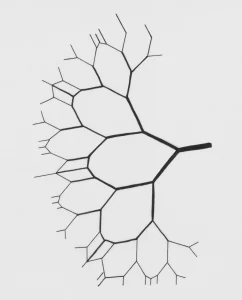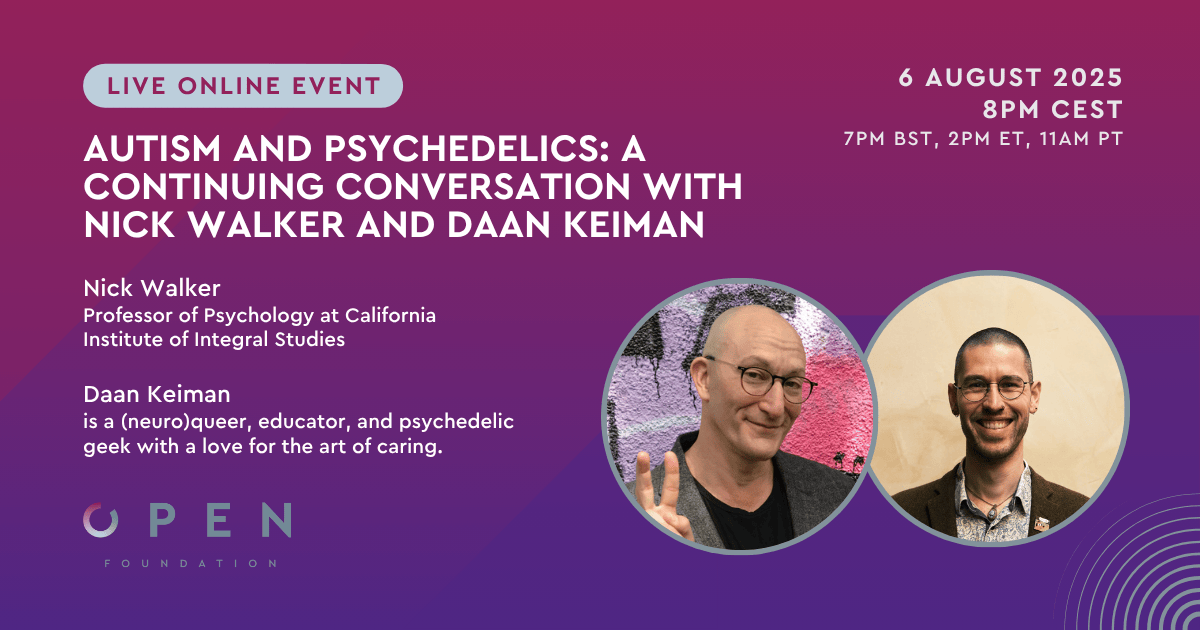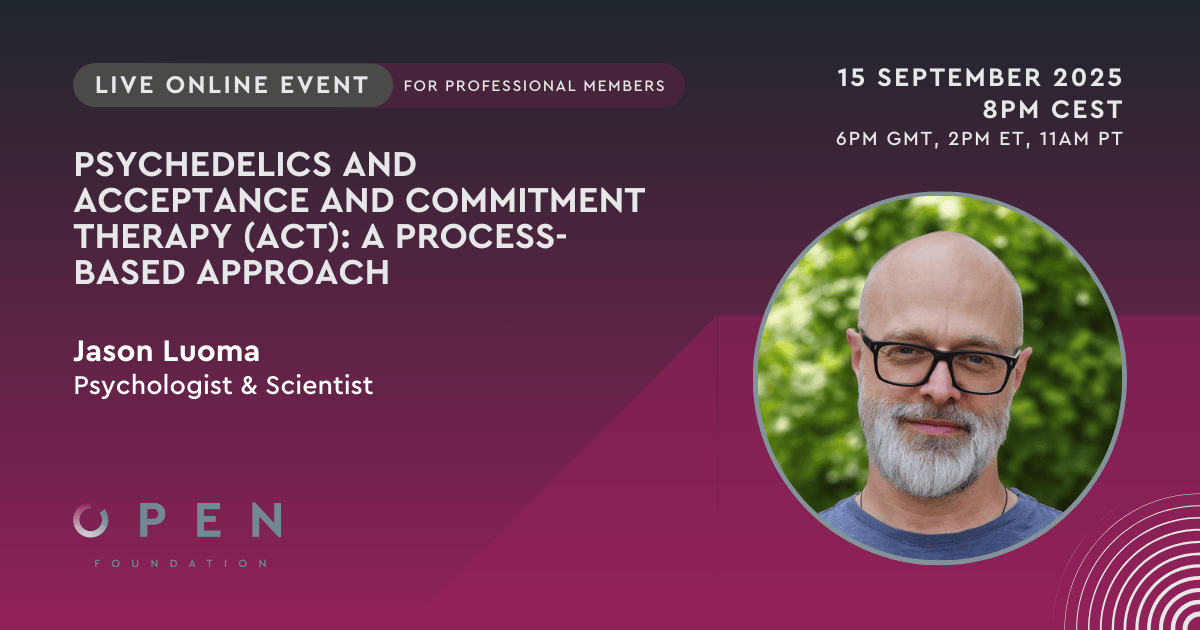After a 20 year study-shutdown on psychedelics, a second wave of interest in the nature and applications of these compounds has engulfed the international research community and rendered a wealth of studies. To help you find your way in the forest of exciting information, this two-part series of articles provides an overview of contemporary (1990 – present) psychedelic research themes. Part 1 will focus on more fundamental research, while part 2 will focus on clinical research.
Part 1: Fundamental psychology
Before getting to the exciting part of this article where we will dive into studies that are done in the psychology field, let’s start with some definitions and explanations. According to the American Psychological Association (APA, 2014), psychology is:
“… the study of the mind and behavior. The discipline embraces all aspects of the human experience — from the functions of the brain to the actions of nations, from child development to care for the aged. In every conceivable setting from scientific research centers to mental healthcare services, “the understanding of behavior” is the enterprise of psychologists.”
For the sake of clearance, conciseness and convenience, the studies with a psychological character will be discussed in two separate articles with a distinction being made between fundamental and clinical research. This first part of the series of psychedelic research themes 2.0 will provide an overview of fundamental research. Fundamental research aims at exposing the general processes that underlie the phenomena of interest and does not necessarily have a direct application. Clinical research tends to be of a more practical nature, since it is primarily aimed at understanding a particular disease or maladjustment and searching for an adequate cure. Though these classes are treated as distinct in this series, please keep in mind that there is a considerable overlap and synergy between the two.
In the fundamental corner, roughly four psychedelic research themes that have been under the microscope for the past twenty years will be distinguished in this article. These concern matters related to cognition, creativity, personality and psychopharmacology.
Cognition
Cognition is a broad term and can be defined in several ways depending on the discipline in which it is used. In neuroscience, cognition is usually considered from the information processing view, explaining human behavior in terms of executive functions. Put simply: there is input (perceptual information), there is output (behavior), and there is something happening in the black box that is known as the brain (executive functions). Cognition usually refers to the total package of processes that is involved in this ongoing cycle of day to day functioning.
Psychedelics exert an acute influence on a variety of these functions, which have been extensively studied with behavioral tasks and neuroimaging techniques. Conclusions about the exact nature of this temporary alteration in cognition have been mixed and even contradictory, which might partially be due to the inconsistency of the study design and substance involved. Amongst others, acute changes in working memory, attention and perception have been described in the literature (for a comprehensive overview, see Passie, Halpern, Stichtenoth, Emrich, & Hintzen, 2008; Bouso, Fábregas, Antonijoan, Rodríguez-Fornells, & Riba, 2013). The fine-tuning of the knowledge that is currently available about the relation between psychedelics and cognitive skills goes hand in hand with increasing information about receptor binding sites, localization of function and brain connectivity.
More standardized study designs seem to be a necessity to learn more about the causes of the inconclusive evidence.
Creativity
From Nevole’s (1947, as cited in Winkler & Csémy, 2014) point of view “…the normal human way of perceiving and thinking, is just one possibility out of many potential possibilities”. He argues that ‘normal’ perception, thoughts and behavior of an individual are the result of socio-cultural learning. The integration of culturally established norms and values might have an evolutionary purpose, but may put constrain on cognitive processes such as creativity.
In psychological literature, creativity is usually defined in terms of divergent thinking: the ability to generate multiple answers to a set problem (Guilford, 1966). Because the psychedelic experience is characterized by an alteration in perception, changes in emotion and expansion of thought and identity (Sessa, 2008), it is not unthinkable that they could provide an aid to ‘think out of the box’.
During the ’50’s and 60’s, the exploration of creative problem solving under the influence of psychedelic agents was a popular research topic. An interesting article was published by Harman, McKim, Mogar, Fadiman, and Stolaroff (1966) in which the results of an experimental study with LSD were described in a group of men which occupation required creative problem-solving ability. The study consists of objective measures of the effects of LSD on problem solving ability, and subjective ratings of the ability to approach a pre-specified, work-related problem. The latter being one of the strengths of the study, since it permits the participant to consider options in a meaningful context. Some of the mutually agreed on subjective effects of the psychedelic compound seem to correspond to ideas about facilitative conditions under which creativity arises, such as low inhibition and anxiety, the capacity to structure problems in a larger context and high fluency and flexibility of ideation. This article may be considered classic in the psychedelic/creativity domain.
Surprisingly, contemporary research on this exciting topic is scarce, perhaps due to the lack of understanding of the concept of creativity itself, or the methodological challenge to measure it. Results from recent studies that were done with ayahuasca (Frecska, Móré, Vargha, & Luna, 2012) and cannabis (Jones, Blagrove, & Parrott, 2009) suggest the ability of users of psychedelics to produce more original ideas than non-users. It has to be noted here that these are not measures that were taken under the acute intoxication of the substances, but as a comparison between groups that were sober at the time of measurement.
There is a strong need for more studies with intelligent experimental designs in order to understand the source of creativity. The field doesn’t seem to have made full use of the modern imaging techniques, such as electro-encephalography (EEG), functional magnetic resonance imaging (fMRI) and diffusion tensor imaging (DTI) to explore the interaction of acute psychoactive chemistry and creative thinking. Opportunities are waiting here…
Personality
In exploring the interaction between psychedelics and personality, most research follows the nature/nurture discussion of stable versus unstable personality traits. According to Cloninger, Svrakic, & Przybeck (1993) personality can be thought of as a dynamic process between two types of traits. Temperament refers to the more stable, genetically determined set of traits, whereas character can be considered the fine-tuning of personality due to socio-cultural factors.
Evidence in the psychedelic research field suggests that differences exist between users and non-users in both personality domains (Bouso et al., 2012; Grob et al., 1996; Móró, Simon, Bárd, & Rácz, 2011), but this doesn’t answer the question of causality: Are people with a certain set of personality traits more likely to start experimenting with psychedelics, or is there a possibility that these substances can account for shaping personality?
Two recent studies found evidence that certain dimensions of personality which are regarded as stable traits were altered after exposure to ayahuasca (Barbosa, Cazorla, Giglio, & Strassman, 2009) and psilocybin (MacLean, Johnson, & Griffiths, 2011). In the ayahuasca study, differences in the personality aspects reward dependence and harm avoidance were found after repeated exposure to the beverage. A single session of psilocybin seemed to be sufficient to cause a change in the openness to experience dimension.
The results are tentative, but promising: for persons dealing with personality disorders psychedelics might be considered valuable tools. More research on this topic would certainly be encouraged.
Psychopharmacology
Psychopharmacology can be defined as “the study of drugs that affect the brain” (Stahl, 2008). This definition exposes that the psychopharmacologist engages himself in matters related to ‘drugs’, the ‘brain’ and their interaction.
Before diving into contemporary research within this field, it is worth mentioning two pieces of work that are written by Alexander Shulgin (1925 – 2014) – one of the most influential scientists in this field – and his wife Ann Shulgin; PIKHAL, A Chemical Love Story (1991) and TIKHAL, The Continuation (1997). Besides a fictionalized autobiography of these key figures of psychedelic research and a detailed description of over 200 compounds, the books also contain lively and informative subjective research reports from the group of friends in which the substances were ‘tested’. Together, the books cover a wide array of research issues, biochemical information, personal experience and spiritual considerations related to psychedelics.
Back to the 21st century then, in which questions like ‘How do psychedelics manifest itself in the human brain?’ and ‘How does this interaction alter perception and behavior?’ keep persisting. Recent studies have been done to examine the neurobiological mechanisms of ketamine (Hahn et al., 2014), salvia (Johnson, MacLean, Reissig, Prisinzano, & Griffiths, 2011), psilocybin (Muthukumaraswamy et al., 2013) and ayahuasca (dos Santos et al., 2011; Riba et al., 2003; Riba, McIlhenny, Valle, Bouso, & Barker, 2012). Data from substance-by-substance research has led to more holistic neuroscientific theories such as the entropic brain hypothesis, in which a division between two types of consciousness (primary and secondary) is proposed as a way to explain phenomena that can’t be accounted for by a neuroscienfitic perspective on its own (Carhart-Harris et al., 2014).
As substance-by-substance research can provide a stepping stone for theories about human behavior, so can fundamental research complement the understanding of clinical expression. The extensive research that has been done on the role and functioning of the amygdala for example, supports and complements explanations about the effectiveness of antidepressant drugs that are used in the treatment of anxiety and mood related complaints (Crupi, Marino & Cuzzocrea, 2011).
Want to know what this has to do with psychedelics? That, and more will be discussed in the second part of this series: Clinical Research.
References
American Psychology Association. About APA and about psychology. How does the APA define “psychology”? Consulted on July 14, 2014 via http://www.apa.org/support/about/apa/psychology.aspx#answer
Barbosa, P. C., Cazorla, I. M., Giglio, J. S., & Strassman, R. (2009). A six-month prospective evaluation of personality traits, psychiatric symptoms and quality of life in ayahuasca-naive subjects. J Psychoactive Drugs, 41, 205–212. Retrieved from http://www.ncbi.nlm.nih.gov/entrez/query.fcgi?cmd=Retrieve&db=PubMed&dopt=Citation&list_uids=19999673
Bouso, J. C., Fábregas, J. M., Antonijoan, R. M., Rodríguez-Fornells, A., & Riba, J. (2013). Acute effects of ayahuasca on neuropsychological performance: differences in executive function between experienced and occasional users. Psychopharmacology, 230(3), 415–24. doi:10.1007/s00213-013-3167-9
Bouso, J. C., González, D., Fondevila, S., Cutchet, M., Fernández, X., Ribeiro Barbosa, P. C., … Riba, J. (2012). Personality, psychopathology, life attitudes and neuropsychological performance among ritual users of ayahuasca: A longitudinal study. PLoS ONE, 7. doi:10.1371/journal.pone.0042421
Calder, a J., Lawrence, a D., & Young, a W. (2001). Neuropsychology of fear and loathing. Nature Reviews. Neuroscience, 2(5), 352–63. doi:10.1038/35072584
Carhart-Harris, R. L., Leech, R., Hellyer, P. J., Shanahan, M., Feilding, A., Tagliazucchi, E., … Nutt, D. (2014). The entropic brain: a theory of conscious states informed by neuroimaging research with psychedelic drugs. Frontiers in Human Neuroscience, 8(February), 20. doi:10.3389/fnhum.2014.00020
Cloninger, C. R., Svrakic, D. M., & Przybeck, T. R. (1993). A psychobiological model of temperament and character. Archives of General Psychiatry, 50, 975–990. doi:10.1001/archpsyc.1993.01820240059008
Cupri, R., Marino, A., Cuzzocrea, S. (2011). New therapeutic strategy for mood disorders. Current Medicinal Chemistry, 18, 4284-4298. doi: 10.2174/092986711797200417
Dos Santos, R. G., Valle, M., Bouso, J. C., Nomdedéu, J. F., Rodríguez-Espinosa, J., McIlhenny, E. H., … Riba, J. (2011). Autonomic, Neuroendocrine, and Immunological Effects of Ayahuasca. Journal of Clinical Psychopharmacology. doi:10.1097/JCP.0b013e31823607f6
Frecska, E., Móré, C. E., Vargha, A., & Luna, L. E. (2012). Enhancement of Creative Expression and Entoptic Phenomena as After-Effects of Repeated Ayahuasca Ceremonies. Journal of Psychoactive Drugs. doi:10.1080/02791072.2012.703099
Grob, C. S., McKenna, D. J., Callaway, J. C., Brito, G. S., Neves, E. S., G., O., … Boone, K. B. (1996). Human pharmacology of hoasca, a plant hallucinogen used in ritual context in Brazil. The Journal of Nervous and Mental Disease, 184(2), 86–94.
Hahn, A., Höflich, A. S., Winkler, D., Sladky, R., Baldinger, P., Vanicek, T., … Lanzenberger, R. (2014). Acute ketamine infusion alters functional connectivity between dorsal attention and default mode networks, 11(9), 2014.
Harman, W. W., McKim, R. H., Mogar, R. E., Fadiman, J., & Stolaroff, M. J. (1966). Psychedelic Agents in Creative Problem-Solving. A pilot study. Psychological Reports, 19(2), 211–227.
Johnson, M. W., MacLean, K. a, Reissig, C. J., Prisinzano, T. E., & Griffiths, R. R. (2011). Human psychopharmacology and dose-effects of salvinorin A, a kappa opioid agonist hallucinogen present in the plant Salvia divinorum. Drug and Alcohol Dependence, 115(1-2), 150–5. doi:10.1016/j.drugalcdep.2010.11.005
Jones, K. a., Blagrove, M., & Parrott, a. C. (2009). Cannabis and Ecstasy/MDMA: Empirical Measures of Creativity in Recreational Users. Journal of Psychoactive Drugs, 41(4), 323–329. doi:10.1080/02791072.2009.10399769
MacLean, K. A., Johnson, M. W., & Griffiths, R. R. (2011). Mystical experiences occasioned by the hallucinogen psilocybin lead to increases in the personality domain of openness. Journal of Psychopharmacology. doi:10.1177/0269881111420188
Móró, L., Simon, K., Bárd, I., & Rácz, J. (2011). Voice of the Psychonauts: Coping, Life Purpose, and Spirituality in Psychedelic Drug Users. Journal of Psychoactive Drugs. doi:10.1080/02791072.2011.605661
Muthukumaraswamy, S. D., Carhart-Harris, R. L., Moran, R. J., Brookes, M. J., Williams, T. M., Errtizoe, D., … Nutt, D. J. (2013). Broadband cortical desynchronization underlies the human psychedelic state. The Journal of Neuroscience : The Official Journal of the Society for Neuroscience, 33(38), 15171–83. doi:10.1523/JNEUROSCI.2063-13.2013
Passie, T., Halpern, J. H., Stichtenoth, D. O., Emrich, H. M., & Hintzen, A. (2008). The pharmacology of lysergic acid diethylamide: a review. CNS Neuroscience & Therapeutics, 14(4), 295–314. doi:10.1111/j.1755-5949.2008.00059.x
Phelps, E. A., & LeDoux, J. E. (2005). Contributions of the amygdala to emotion processing: from animal models to human behavior. Neuron, 48(2), 175–87. doi:10.1016/j.neuron.2005.09.025
Riba, J., McIlhenny, E. H., Valle, M., Bouso, J. C., & Barker, S. a. (2012). Metabolism and disposition of N,N-dimethyltryptamine and harmala alkaloids after oral administration of ayahuasca. Drug Testing and Analysis, 4, 610–6. doi:10.1002/dta.1344
Riba, J., Valle, M., Urbano, G., Yritia, M., Morte, A., & Barbanoj, M. J. (2003). Human pharmacology of ayahuasca: subjective and cardiovascular effects, monoamine metabolite excretion, and pharmacokinetics. The Journal of pharmacology and experimental therapeutics (Vol. 306, pp. 73–83). doi:10.1124/jpet.103.049882.Britain
Sessa, B. (2008). Is it time to revisit the role of psychedelic drugs in enhancing human creativity? Journal of Psychopharmacology (Oxford, England), 22(8), 821–7. doi:10.1177/0269881108091597
Winkler, P., & Csémy, L. (2014). Self-Experimentations with Psychedelics Among Mental Health Professionals: LSD in the Former Czechoslovakia. Journal of Psychoactive Drugs, 46(1), 11–19. doi:10.1080/02791072.2013.873158













